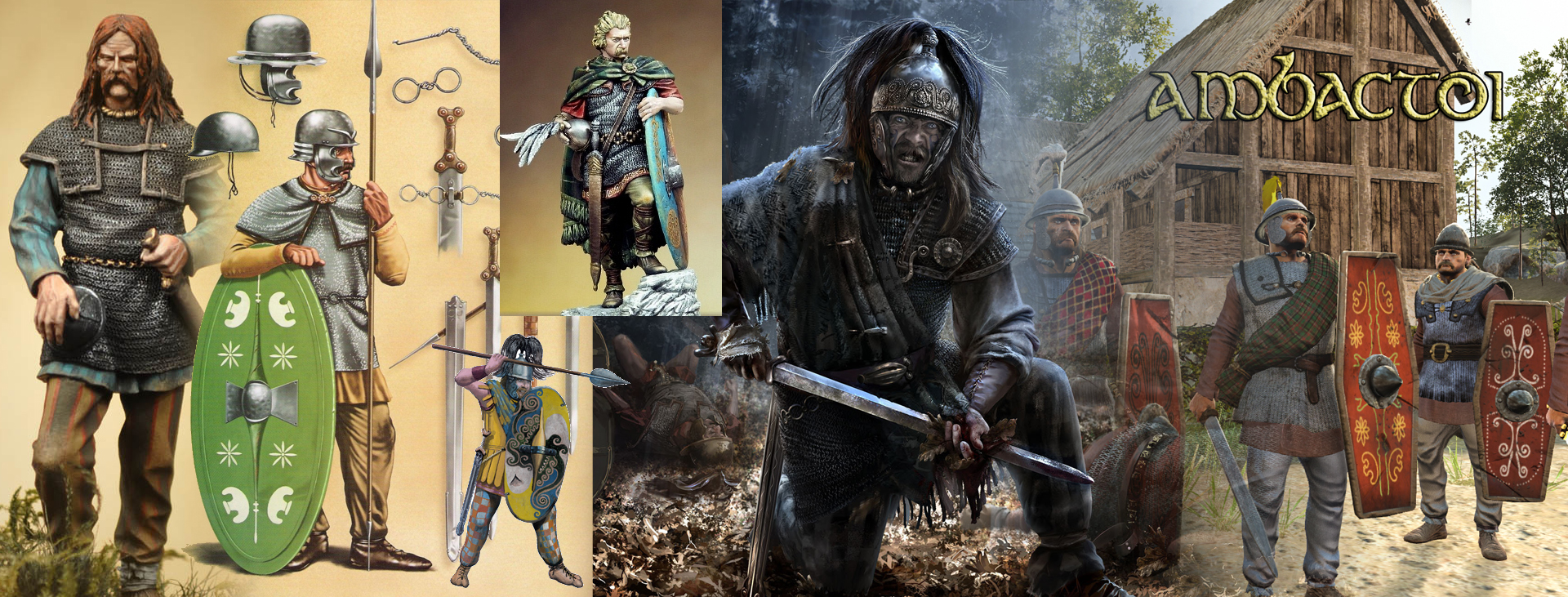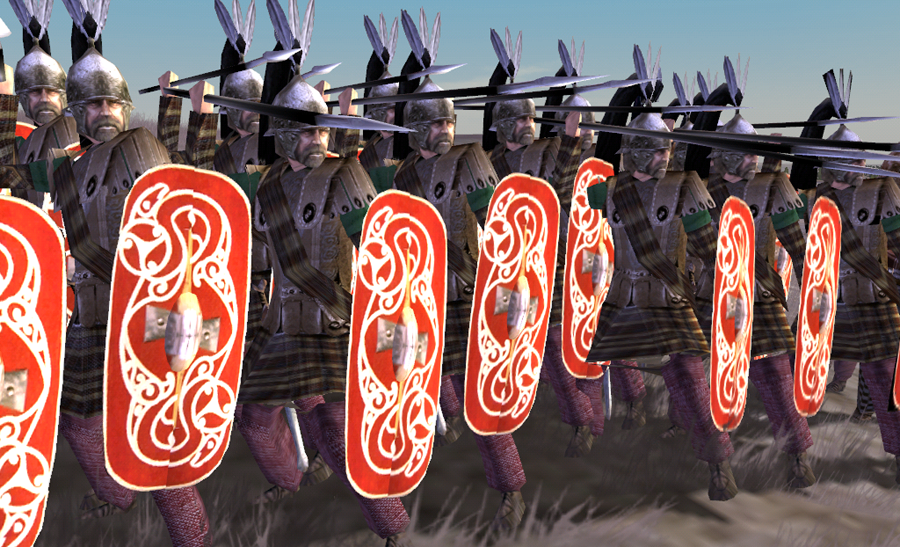The Ambactos
The Celtic Sergeant
A mix of pictures gathered around the internet.
Servant or client warrior ?
About clientelism in celtic society The Ambactos (Ambact) is one of the most foggy social rank/warrior class denomination in ancient Gallic language. Also known in latin Ambactus, this was the addition of amb- & actus, latin equivalents for the gallic term properly designating «one which revolving around» - it is close to "anculus" or ancilliary in latin and conveys this idea of a servant. It could even have a stronger sense, litterraly of a slave. The real Gallic term was probably ambaxtos, and meant vassal, dependent, servant or retainer. It is derived from the old Indo-European “drive around” and left the latin term Ambigo; nowadays "ambiguous". It is still conveying the idea of "revolving around". Another descendant of the term is nowaday's "ambassador".
The Ambactos (Ambact) is one of the most foggy social rank/warrior class denomination in ancient Gallic language. Also known in latin Ambactus, this was the addition of amb- & actus, latin equivalents for the gallic term properly designating «one which revolving around» - it is close to "anculus" or ancilliary in latin and conveys this idea of a servant. It could even have a stronger sense, litterraly of a slave. The real Gallic term was probably ambaxtos, and meant vassal, dependent, servant or retainer. It is derived from the old Indo-European “drive around” and left the latin term Ambigo; nowadays "ambiguous". It is still conveying the idea of "revolving around". Another descendant of the term is nowaday's "ambassador".
As of today the general meaning for archaeologists for the old gaulish is to be a vassal, and high-ranking servant, certainly not a slave. It is very likely the function of ambact was transmitted through the middle age as the French "servant", derived into sergeant. It was not a common warrior, but an higher rank, although still bound by servuce loyalty to the chief. It has been compared to the Soldurii, but the latter is to be understood as a form of "devotio", and close bodyguard of a king, whereas for the Ambact, the notion of bodyguard is here, as well as the rich equipments, compared to the average warrior, but assigned to a local chieftain, a lower rank lord.
Back to De Bello Gallico: "Alterum genus est equitum. Hi, cum est usus atque aliquod bellum incidit (quod fere ante Caesaris adventum quotannis accidere solebat, uti aut ipsi iniurias inferrent aut illatas propulsarent), omnes in bello versantur, 2 atque eorum ut quisque est genere copiisque amplissimus, ita plurimos circum se ambactos clientesque habet. Hanc unam gratiam potentiamque noverunt." Roughly "The other order is that of the knights. These, when there is occasion and any war occurs (which before Caesar's arrival was wont to happen every year, as either they themselves were inflicting injuries or repelling them), are all engaged in war, and the necessity of the more a kind of wealth and resources, so the portion with the great multitudes about him, inflecting, and clients of it has. This is one of esteem and power. We have three notions here: 1-Wealth and equipments, 2-a portion separated of the multitude (in a sense the chosen ones) 3-the notion of client 4-the notion of esteem and power;
Caesar thought that the Ambacti were the property of a notable but it is not even if, according to V. Krutas, they were in a situation close to serfdom. Close only because the ambactos was a warrior, armed and therefore a free man. In fact, they were likely gave up to an influential chief their legal personality against a debt or a reward. The character was to represent them on any legal matter. In return, the ambact had to accompany it at war, and in peacetime, lived as its "protector", and quite handsomely. In wartime, that was likely he would die like his patron, just for failing to defend him. The term was present on coins from the Mediomatrici et des Lexovian tribes.



Part of the composition of each Gallic army
It is true that as it is generally thought, the Ambact was a chosen warrior, picked-up among the regular Gallic warrior class. They were clients of a lord, a local chieftain, which showed its powerf and wealth through the quality of equipments of his own bodyguards, his retinue of ambacts. Compared to the whole Gallic army when called to the field of battle, it is indeed a small fraction. In a large battle line, between for example major nations of the time like the Arverni and Senones, we can certainly see the Vergobret or the King surrounded by a very high elite, crack bodyguard of "Soldurii" either on foot or mounted, and the local aggregation of troops bring by all the villages, headed at the front by their local chieftain, nobles surrounded by their Ambacts, and possibly a champion (Cavaros). Then came their regular soldiers, less well equipped, but still well-trained, disciplined and armed with a lance; the Cingetos. On the wings, elite javelineers-swordsmen but also lower ranks fast Cingetos armed with javelins, naked warriors, youth, slingers, archers on the vanguard, and behind the mass of peasants, either trained like the Bagaudoi (or gaisatoi, armed with a spear) and atecti, untrained levies and some picked-up Batoroi, axemen, macemen, smiths with tools of their trade used as a weapon.
Superb equipment and skills
So the ambact were though to be in each village or town, as a retinue of the local chieftain, either on foot or mounted. Their role was not only to act as bodyguards in all time, but also to train and command the warrior class if needed, while the latter took charge of the training of militias and levies in times of war. Ambacts were masterfully trained, by the proper swordmaster or champion of the chieftain, and superbly equipped, with chainmails, nicely made shields, first-class swords by the personal smith of the lord, plus a three meter lancia which can be used in a variety of ways. As a melee weapon on foot when making the gallic shieldwall or "turtle" formation and as a traditional lance when mounted. In the first case, they fought on the first rank, against their peers, as it would have been seen as dishonorable to fight simple peasants. Bagaudoi were barely trusted, and atecti were only good to bolster the ranks and guard the rear and baggage train. Despite their close cover of the lord, individual bravery and singular feats would have been common within the client system as the lord was likely to bo brag about the skills and bravery of his subordinates and narrate their war actions with much praise and pride. In the same way, individual recoignition mark was probably well tolerated, even though encouraged for the pride of the "team". Bonds and esprit de corps of these chosen warriors would have been probably very strong, proper to reinforce loyalty, and their age probably in the 30s-40s and more. Women, gifts in slaves, wines, sharing of the loot would have also reinforce these bonds. The cavalry, "eporedoi" or "epones" should have been also mounted ambacts.Sources
https://en.wikipedia.org/wiki/ambacthttp://www.forumromanum.org/literature/caesar/gallic6.html
Google Books Ethnologie Gauloise ou Memoires Critiques D.F. Belloguet
Entremont et l'impérium arverne ptie. De Segovese à Hannibal
https://www.mundusbellicus.fr/forum/espace-communautaire/l-agora/histoire/antiquit%C3%A9/503-celtes-vocabulaire-militaire
♕ Aquitani & Vasci ♕ Celts ♕ Indo-greeks ♕ Veneti ♕ Yuezhi ♕ Indians ♕ Etruscans ♕ Numidians ♕ Samnites ♕ Judaean ♕ Ancient Chinese ♕ Corsico-Sardinians
⚔ Cingetos ⚔ Immortals ⚔ Cavaros ⚔ Cataphract ⚔ Romphaiorioi ⚔ Chalkaspidai ⚔ Devotio Warrior ⚔ Scythian Horse archer ⚔ The Ambactos ⚔ Iberian warfare ⚔ Illyrian warriors ⚔ Germanic spearmen ⚔ Carthaginian Hoplite ⚔ Thracian Peltast ⚔ Caetrati ⚔ Ensiferi ⚔ Hippakontistai ⚔ Hastati ⚔ Gaesatae ⚔ Cretan Archer ⚔ Thorakitai ⚔ Soldurii ⚔ Iphikrates ⚔ Kardaka ⚔ The thureophoroi